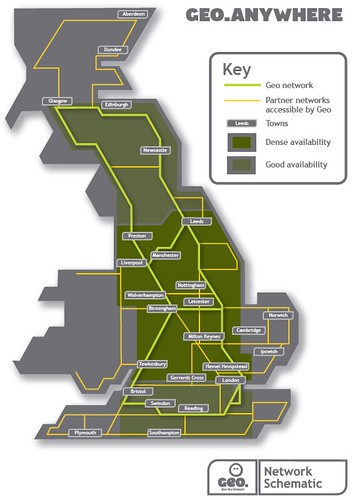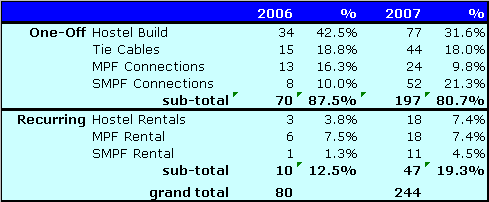The sheer scale of BSkyB’s investment in broadband barely ever gets a mention, but I reckon it is currently around £720m. This is broken down into:
- the two major acquisitions: Easynet of £223m and 365Media of £105m of which I estimate around £60m was broadband and the other being the betting assets.
- the fixed capex of £130m and success-based capex of around £45m
- the operating losses of £232m in Sky Broadband and £40m in Easynet, less around £10m of depreciation of the capex.
Losses and Investments are expected to continue until 2010, when I estimate that total investment will be around £1bn and that is a big number for people who think that access providers will be relegated to a future role of being mere bit shifters.
Broadband ProgressNet adds of both Sky Broadband and Sky Talk are currently doing extremely well in a very competitive market and if the current pace is continued the goals of 3m broadband and 1.5m Talk customers should be easily achieved. I estimate that at the current pace, Sky will have around 3.4m broadband and 2m talk customers. Although, these figures sound a lot they will still leave Sky in the #3 position behind BT and Virgin Media. I do not think it is in the DNA of Sky to languish in third place, so I expect the onslaught to continue post-2010.
Operating losses of £51m in Sky Broadband, which includes SkyTalk, are extremely high, but probably have peaked unless the pace of subscriber acquisition picks up. Sky writes off the approx. £80/customer SAC costs as they are incurred and with 233k net adds in the quarter the total SAC charge to P&L will be around £18m. Average ARPU of £16/customer is slightly ahead of target. However, what is not known is the rate of churn within the Sky Broadband service and this is the key statistic on such a low ARPU.
B2BOne element of the Easynet acquisition which is slightly disappointing is the seeming lack of progress on the Enterprise side. Easynet made losses of £6m on overall turnover of £40m in the quarter.
One thing that I have noticed is that David Rowe (the CEO of Easynet) is also now responsible for the Sky Business division which sells TV into pubs, clubs, hotels and businesses. I would imagine Easynet to start leveraging these relationships and cross selling voice and data into this customer base.
The frightening thing about the B2B voice and data market is that it isn’t very profitable; companies such as Colt and Thus have been around for years without making much money. I am really struggling to see where Easynet see that they have an edge in this market in the medium term. I wouldn’t be surprised to see the Enterprise division being sold in the medium term.
Massive Local StorageThe Sky platform architecture is not just about adding an always on broadband capability to the satellite download capability; it also requires a big fat hard disk with plenty of storage integrated into the set top box. This is delivered via either the new Sky+ boxes or the HD boxes. In total Sky have just over 3m homes with storage in the front room out of a total of 8.7m or just over 35% of homes.
This can be seen as another financial investment for Sky because every Sky+ box requires an approximate £100 SAC charge to P&L. The problem here is that for most customers it is not just a question of sending out a box, because a second feed is required from the satellite dish and this requires a visit from an engineer. The best solution for Sky would be if existing customers either purchase the Sky HD service or purchase a multiroom service and thereby reducing the payback period.
The Sky multiroom service is probably the only service that seems in danger of missing its target of 3m homes by 2010 at current takeup rates. I can imagine the pace picking up slightly as Digital Switchover occurs in the main populated regions and people start to discover that indoor coverage on second and third TV’s is poor without connection to an external aerial. However, I expect this service to miss its 2010 targets without further action such as a price drop.
Sky+ has already met its 2.5m homes target and I suspect that even Sky themselves are surprised at the popularity of the product. It has definitely crossed the chasm into a mainstream must-have consumer product and I suspect that demand in the next quarter will be extremely high. Some families this Christmas will be worried whether the Sky engineer will arrive before Santa.
Next year will present an interesting dilemma for Sky as the tired looking EPG gets a makeover. Customers with old Set Top Boxes will probably not have the capability of receiving an EPG upgrade and therefore they will need either a new box. Sky with its anti-churn policy of treating its most faithful and longest serving customers fairly will probably have to offer them a better deal on the Sky+ boxes which will involve an even greater subsidy. I expect this rollout to happen next summer when engineering demand is lightest.
All told, the investment in Sky+ will probably be a drag on earnings for the next couple of years. I can easily see Sky investing £25m per quarter in Sky+ until 2010.
DTHDTH is on target for 10m homes by 2010, but it is not doing exceptionally well in the UK.
In Ireland, DTH is doing much better and I think Irish home penetration (approx 34%) is now higher than the UK (approx 32%). The reason for this is that Ireland still has a lot of analogue cable (268k) compared to digital cable (297k), whereas Sky had 513k subscribers as at Sept 2007. Analogue Cable is a bit of a misnomer because a lot of these analogue customers are actually rural and limited channels is delivered via a wireless technology called MMDS. It also helps that the Irish economy is growing at a greater pace than the UK and doesn’t currently have a DTT service.
In the UK competition is fierce with Virgin Media, Setanta on DTT and BT aiming for the low end Sky customers. The fact that Sky managed to add 67k in this environment is testament to the strength of the Sky brand. Although, it is hard to disentangle all the working parts of the Sky machine, the majority of the new adds seem to be See, Speak and Surf subscribers which probably add more weight to the timeliness of the broadband strategy.
Cost BaseApart from the economies of scale inherent in the content business and more especially the premium sports, there are another couple of extras benefits which should start filtering through in the next couple of quarters. The first is the completion of the EDS trial, through this will probably be offset by extra costs from the regulatory and legal battles that Sky will need to keep fighting with OFCOM, Virgin Media and the rest. The second is that the USD:GBP exchange rate is definitely moving in Sky favour, currently because of their hedging strategy benefits (or costs) actually lag the actual exchange rate. Performance in the current quarter was a £3m gain with a hedged exchange rate of around 1.86.
Potential DownsidesThe main potential downside is that Sky will lose its various regulatory battles handing an advantage to its competitors. Although a negative outcome in the ITV enquiry could cause some short term financial pain, the payTV DTT OFCOM is I believe of far more long term strategic importance. Also, I wouldn’t be at all surprised if Virgin Media drop their content carriage case with the appointment of a new CEO and some sort of face saving settlement is worked out.
However, an increase in investment could also spook the stock market and there are four main broad areas which could involve a lot of money:
- launching broadband in Ireland
- increase of exchange footprint above the current 70%
- more investment in the B2B market; and most expensively
- Fibre investment
All told, Sky is currently executing well on its plans and its plans should be a big concern for the rest of the market. Long term, the only really dark clouds on the horizon is the DTT enquiry and potentially a BT-led FTTH programme which could leave Sky with a lot of stranded assets unless they launch a fierce political and regulatory fight.








